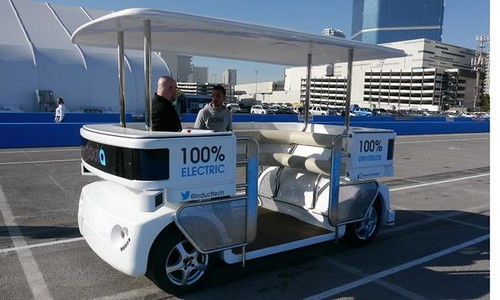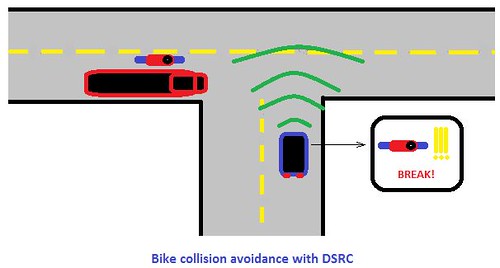Google is now developing self-driving prototype cars. The driver will be able to summon the car using a smartphone application and the car will automatically drive to the destination selected on the app, the New York Times reported.
It doesn’t have a steering wheel, accelerator pedal, or brake pedal. Their software and sensors do all the work.
The electric-powered car is simple: two seats, two buttons and a screen that displays the route. Google is having 100 cars built by a manufacturer in the Detroit area, which it declined to name.
Ultra-light mass transit and self-driving, rubber-wheeled people movers could be an answer for urban transportation. They are fast, light, clean, comfortable and can connect neighborhoods to high speed transit.
Modified Neighborhood Electric Vehicles or 2-passenger vehicles, like GM’s EN-V, could cross bridges on bike-wide lanes. No rails or overhead power. No drivers, either.
England’s autonomous car project in the city of Milton Keynes may be the first real-world test of self-driving cars.
The autonomous Navia shuttle can fit up to 10 people and is designed to accommodate a wheelchair. It is currently being tested on college campuses in Switzerland, Britain and Singapore.
Navia uses anchor points to see along its prescribed course and costs around $250,000, but the company says operating a conventional shuttle service, with drivers, fuel and maintenance, costs roughly the same.
Vehicle-to-vehicle communications is expected to be standardized by 2017, and sometime around 2020, cars will communicate with each other and alert drivers to roadside hazards ahead, reports ExtremeTech.
V2V is also known as VANET (Vehicular ad hoc network) is a variation of MANET (Mobile ad hoc network), where the node is the vehicle.
Dedicated short-range communications (DSRC) technology, in the 5.9 GHz band, provides vehicle-to-vehicle and vehicle-to-infrastructure to improve safety and mobility, says the DOT.
Mark Reuss, GM’s executive VP of global product development, told Bloomberg that he could see Google becoming a “serious competitive threat”. GM demonstrated Super Cruise last year, which supports semi-automated driving features including hands-off lane following, braking and speed control.
The National Highway Traffic Safety Administration says the first generation of V2V systems would warn the driver but not take control of the car. Later implementations would improve to brake or steer around obstacles and eventually merge with self-driving cars.
Demographics of car ownership are shifting. Younger people are moving towards mass transit.
A Columbia University report, entitled Transforming Personal Mobility (pdf), suggests that shared AV’s could provide metro area transportation at a total cost per mile between 15 and 41 cents. They will offer safer, faster, more convenient and usually cheaper trips than public transit.
Intel’s Freeway to the Future survey found almost half of Americans aspire to live in a driverless city; more than one-third believe it will happen this decade. Intel wants to make the Atom processor the brains of the connected car, reports GigaOm.
In-Vehicle Solutions will use Linux-based middleware on top of which automakers can build their infotainment user interface and apps. The idea is to help automakers cut down on their long development times. Chipmakers with designs on the car also include Nvidia, Qualcomm, Broadcom and Texas Instruments.
Once automakers start adding the technology to all new cars, it is estimated to take 15 years or more for half the cars on the nation’s roads to be equipped, according to Qualcomm.
Drivers would also be alerted to a possible collision with a pedestrian or bicycle carrying a smartphone that continually sends out information to cars in the vicinity, even if it’s too dark to see the person or if the pedestrian darts suddenly into traffic.
Vehicular communications is usually developed as a part of Intelligent Transport Systems (ITS) which integrates communication between mobile and fixed nodes, using both wired and wireless communications.
Bill Ford, executive chairman of the Ford Motor Company, proposed partnering with the telecommunications industry to create cities in which “pedestrian, bicycle, private cars, commercial and public transportation traffic are woven into a connected network to save time, conserve resources, lower emissions and improve safety.”
Here’s My Proposal for self-driving cars in Portland.
Five years ago infotainment ranked 27th on a list of features most cars shopper wanted. Now it’s in the top five.
According to research firm Analysys Mason, 11.5 million connected cars will ship this year, growing to around 170 million in 2023. General Motors’ OnStar service currently has 6 million customers. Worldwide sales of HUD-equipped cars will increase from 1.2 million units in 2012 to 9.1 million in 2020.
Related DailyWireless stories on transit connectivity include; Google and Apple Battle for Connected Car, Audi Dumps T-Mobile for AT&T Connected Car, Vehicle to Vehicle Communications: Moving Forward?, World Congress on Talking Cars, and 5.9 GHz Hits the Road Inside Google’s Driverless Car, Driverless Cars Rolling Out in UK, Autonet Does Control and Diagnostic Apps, Verizon Forms Connected Car Venture, Automotive Telematics Goes 4G, Ford Lowers SYNC Costs, Google’s Driverless Car Explained, World Congress on Talking Cars, Connected Car Conference,
Posted on Fri, 30 May 2014 02:54:49 +0000 at http://www.dailywireless.org/2014/05/29/...ng-cars-2/
Comments: http://www.dailywireless.org/2014/05/29/.../#comments







